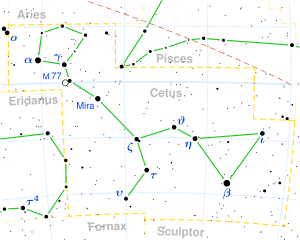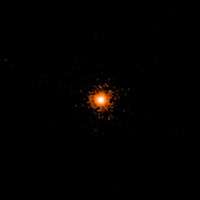Beta Ceti
 | |
| Observation data Epoch J2000 Equinox J2000 | |
|---|---|
| Constellation | Cetus |
| Right ascension | 00h 43m 35.37090s[1] |
| Declination | –17° 59′ 11.7827″[1] |
| Apparent magnitude (V) | 2.02[2] |
| Characteristics | |
| Spectral type | K0 III[3] |
| U−B color index | +0.88[2] |
| B−V color index | +1.01[2] |
| Variable type | Suspected[4] |
| Astrometry | |
| Radial velocity (Rv) | +12.9[5] km/s |
| Proper motion (μ) | RA: +232.55[1] mas/yr Dec.: +31.99[1] mas/yr |
| Parallax (π) | 33.86 ± 0.16[1] mas |
| Distance | 96.3 ± 0.5 ly (29.5 ± 0.1 pc) |
| Absolute magnitude (MV) | –0.13[6] |
| Details | |
| Mass | 2.8[7] M☉ |
| Radius | 16.78 ± 0.25[8] R☉ |
| Luminosity | 139.1 ± 7.0[8] L☉ |
| Surface gravity (log g) | 2.7[9] cgs |
| Temperature | 4,797[9] K |
| Metallicity [Fe/H] | –0.09[9] dex |
| Rotational velocity (v sin i) | 18[10] km/s |
| Age | > 1[11] Gyr |
| Other designations | |
| Database references | |
| SIMBAD | data |
| ARICNS | data |
Beta Ceti (β Ceti, abbreviated Beta Cet, β Cet), also named Diphda,[13] is the brightest star in the constellation of Cetus. Although designated 'beta', it is actually brighter than the 'alpha' star in the constellation (Alpha Ceti). This orange giant is easy to identify due to its location in an otherwise dark section of the celestial sphere. Based on parallax measurements, it lies at an estimated distance of 96.3 light-years (29.5 parsecs) from the Sun.[1]
Properties

Diphda has an apparent visual magnitude of 2.02,[2] making it the brightest star in Cetus. The stellar classification of this star is K0 III,[3] although some sources list a classification of G9.5 III[7] indicating that it lies along the dividing line separating G-type from K-type stars. The luminosity class of 'III' means that it is a giant star that has consumed the hydrogen at its core and evolved away from an A-type main sequence star.[7] After passing through the red giant stage, it underwent the helium flash event and is generating energy through the thermonuclear fusion of helium at its core.[14] Beta Ceti will remain in this mode for over 100 million years.[11]
The effective temperature of the star's outer envelope is about 4,797 K,[9] giving it the characteristic orange hue of a K-type star.[15] In spite of its cooler temperature, Diphda is much brighter than the Sun with a bolometric luminosity of about 145 times the luminosity of the Sun,[16] resulting from a radius 18[8] times as large as the Sun and a mass that is 2.8 times the Sun's mass.[7]
This star displays flaring activity that results in random outbursts that increase the luminosity of the star over intervals lasting several days. This is a much longer duration than for comparable solar flare activity on the Sun, which typically last for periods measured in hours.[14] In 2005, a relatively high rate of X-ray emission was detected with the XMM-Newton space observatory.[7] It is emitting about 2,000 times the X-ray luminosity of the Sun, allowing the star to be imaged with the Chandra X-ray Observatory.[11]
Nomenclature
β Ceti (Latinised to Beta Ceti) is the star's Bayer designation.
It bore the traditional names Diphda and Deneb Kaitos. Diphda is Arabic for 'frog', from the phrase ضفدع الثاني aḍ-ḍifdaʿ aṯ-ṯānī 'the second frog' (the first frog' is Fomalhaut); Deneb Kaitos is from ألذنب ألقيتوس ألجنوب Al Dhanab al Ḳaiṭos al Janūbīyy 'southern tail of Cetus'.[17]
In 2016, the International Astronomical Union organized a Working Group on Star Names (WGSN)[18] to catalogue and standardize proper names for stars. The WGSN approved the name Diphda for this star on 21 August 2016 and it is now so entered in the IAU Catalog of Star Names.[13]
In Chinese astronomy, Deneb Kaitos is called 土司空, Pinyin: Tǔsīkōng, meaning Master of Constructions, because this star is marking itself and stands alone in the Master of Constructions asterism, Legs mansion (see : Chinese constellation).[19] 土司空 (Tǔsīkōng), westernized into Too Sze Kung by R.H. Allen and the meaning is "Superintendent of Earthworks."[20]
Namesake
USS Diphda (AKA-59) was a U.S. Navy ship.
See also
- Lists of stars in the constellation Cetus
References
- 1 2 3 4 5 6 van Leeuwen, F. (November 2007). "Validation of the new Hipparcos reduction". Astronomy and Astrophysics. 474 (2): 653–664. arXiv:0708.1752. Bibcode:2007A&A...474..653V. doi:10.1051/0004-6361:20078357.
- 1 2 3 4 Johnson, H. L.; et al. (1966), "UBVRIJKL photometry of the bright stars", Communications of the Lunar and Planetary Laboratory, 4 (99): 99, Bibcode:1966CoLPL...4...99J
- 1 2 Montes, D.; et al. (November 2001), "Late-type members of young stellar kinematic groups - I. Single stars", Monthly Notices of the Royal Astronomical Society, 328 (1): 45–63, arXiv:astro-ph/0106537, Bibcode:2001MNRAS.328...45M, doi:10.1046/j.1365-8711.2001.04781.x
- ↑ Samus, N. N.; Durlevich, O. V.; et al. (2009). "VizieR Online Data Catalog: General Catalogue of Variable Stars (Samus+ 2007-2013)". VizieR On-line Data Catalog: B/gcvs. Originally published in: 2009yCat....102025S. 1. Bibcode:2009yCat....102025S.
- ↑ Wielen, R.; et al. (1999), "Sixth Catalogue of Fundamental Stars (FK6). Part I. Basic fundamental stars with direct solutions", Veröff. Astron. Rechen-Inst. Heidelb, Astronomisches Rechen-Institut Heidelberg, 35 (35), Bibcode:1999VeARI..35....1W
- ↑ Elgarøy, Øystein; Engvold, Oddbjørn; Lund, Niels (March 1999), "The Wilson-Bappu effect of the MgII K line - dependence on stellar temperature, activity and metallicity", Astronomy and Astrophysics, 343: 222–228, Bibcode:1999A&A...343..222E
- 1 2 3 4 5 Sägesser, S. N.; Jordan, C. (March 2005). "Emission measures for the single giant β Ceti". In Favata, F.; Hussain, G. A. J.; Battrick, B. Proceedings of the 13th Cambridge Workshop on Cool Stars, Stellar Systems and the Sun, held 5–9 July 2004 in Hamburg, Germany. European Space Agency. p. 931. Bibcode:2005ESASP.560..931S.
- 1 2 3 Berio, P.; et al. (November 2011), "Chromosphere of K giant stars. Geometrical extent and spatial structure detection", Astronomy & Astrophysics, 535: A59, arXiv:1109.5476, Bibcode:2011A&A...535A..59B, doi:10.1051/0004-6361/201117479
- 1 2 3 4 Massarotti, Alessandro; et al. (January 2008). "Rotational and Radial Velocities for a Sample of 761 HIPPARCOS Giants and the Role of Binarity". The Astronomical Journal. 135 (1): 209–231. Bibcode:2008AJ....135..209M. doi:10.1088/0004-6256/135/1/209.
- ↑ "Bright Star Catalogue, 5th Revised Ed. (Hoffleit+, 1991)". VizieR. Centre de Données astronomiques de Strasbourg. Retrieved 2010-09-30.
- 1 2 3 "Beta Ceti: Giant Star's Corona Brightens with Age". Chandra Photo Album. Harvard-Smithsonian Center for Astrophysics. February 20, 2009. Retrieved 2011-12-28.
- ↑ "bet Cet -- Variable Star". SIMBAD. Centre de Données astronomiques de Strasbourg. Retrieved 2010-09-30.
- 1 2 "IAU Catalog of Star Names". Retrieved 28 July 2016.
- 1 2 Ayres, Thomas R.; Osten, Rachel A.; Brown, Alexander (November 2001). "3 Ms in the Life of β Ceti: Sustained Flare Activity on a Clump Giant Detected by the Extreme Ultraviolet Explorer". The Astrophysical Journal. 562 (1): L83–L86. Bibcode:2001ApJ...562L..83A. doi:10.1086/337971.
- ↑ "The Colour of Stars", Australia Telescope, Outreach and Education, Commonwealth Scientific and Industrial Research Organisation, December 21, 2004, archived from the original on 2012-03-10, retrieved 2012-01-16
- ↑ Kaler, James B. "DENEB KAITOS (Beta Ceti)". University of Illinois. Retrieved 2010-09-30.
- ↑ Allen, Richard H. (1963). Star Names: Their Lore and Meaning (Reprint ed.). New York: Dover Publications Inc. p. 163. ISBN 0-486-21079-0. Retrieved 2010-12-12.
- ↑ IAU Working Group on Star Names (WGSN), International Astronomical Union, retrieved 22 May 2016.
- ↑ (in Chinese) AEEA (Activities of Exhibition and Education in Astronomy) 天文教育資訊網 2006 年 7 月 9 日
- ↑ Star Name - R.H. Allen p. 160